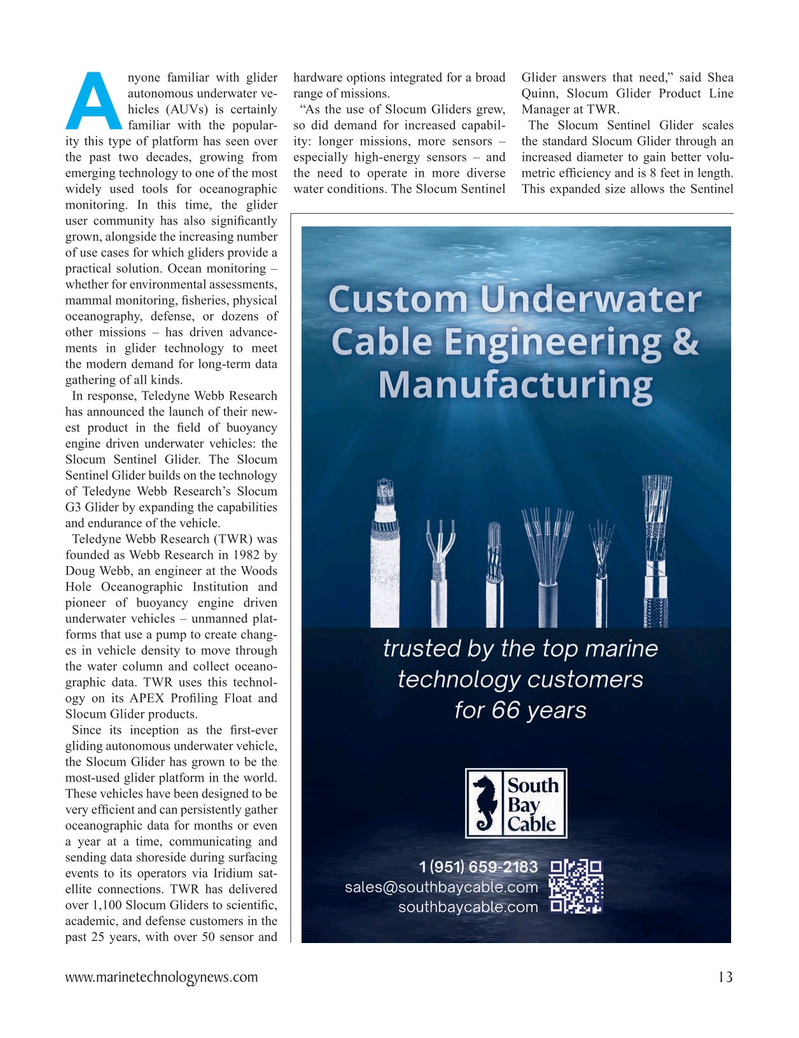
Page 13: of Marine Technology Magazine (March 2024)
Read this page in Pdf, Flash or Html5 edition of March 2024 Marine Technology Magazine
nyone familiar with glider hardware options integrated for a broad Glider answers that need,” said Shea autonomous underwater ve- range of missions. Quinn, Slocum Glider Product Line hicles (AUVs) is certainly “As the use of Slocum Gliders grew, Manager at TWR.
A familiar with the popular- so did demand for increased capabil- The Slocum Sentinel Glider scales ity this type of platform has seen over ity: longer missions, more sensors – the standard Slocum Glider through an the past two decades, growing from especially high-energy sensors – and increased diameter to gain better volu- emerging technology to one of the most the need to operate in more diverse metric ef? ciency and is 8 feet in length. widely used tools for oceanographic water conditions. The Slocum Sentinel This expanded size allows the Sentinel monitoring. In this time, the glider user community has also signi? cantly grown, alongside the increasing number of use cases for which gliders provide a practical solution. Ocean monitoring – whether for environmental assessments, mammal monitoring, ? sheries, physical oceanography, defense, or dozens of other missions – has driven advance- ments in glider technology to meet the modern demand for long-term data gathering of all kinds.
In response, Teledyne Webb Research has announced the launch of their new- est product in the ? eld of buoyancy engine driven underwater vehicles: the
Slocum Sentinel Glider. The Slocum
Sentinel Glider builds on the technology of Teledyne Webb Research’s Slocum
G3 Glider by expanding the capabilities and endurance of the vehicle.
Teledyne Webb Research (TWR) was founded as Webb Research in 1982 by
Doug Webb, an engineer at the Woods
Hole Oceanographic Institution and pioneer of buoyancy engine driven underwater vehicles – unmanned plat- forms that use a pump to create chang- es in vehicle density to move through the water column and collect oceano- graphic data. TWR uses this technol- ogy on its APEX Pro? ling Float and
Slocum Glider products.
Since its inception as the ? rst-ever gliding autonomous underwater vehicle, the Slocum Glider has grown to be the most-used glider platform in the world.
These vehicles have been designed to be very ef? cient and can persistently gather oceanographic data for months or even a year at a time, communicating and sending data shoreside during surfacing events to its operators via Iridium sat- ellite connections. TWR has delivered over 1,100 Slocum Gliders to scienti? c, academic, and defense customers in the past 25 years, with over 50 sensor and www.marinetechnologynews.com 13
MTR #3 (1-17).indd 13 4/4/2024 9:39:23 AM

 12
12

 14
14
